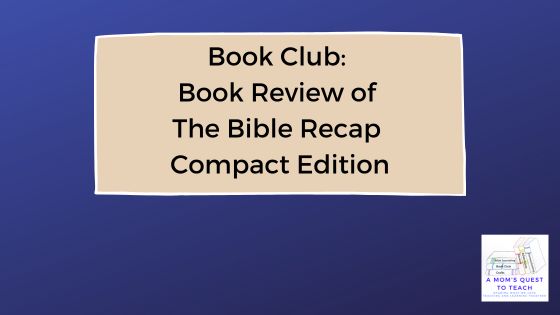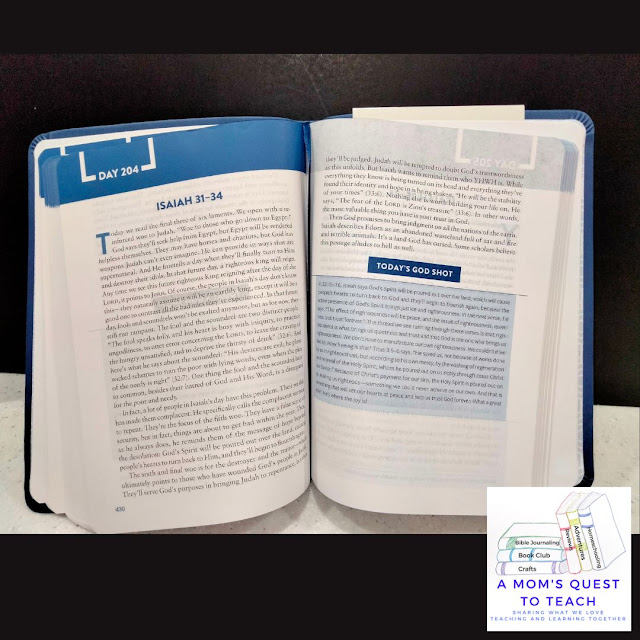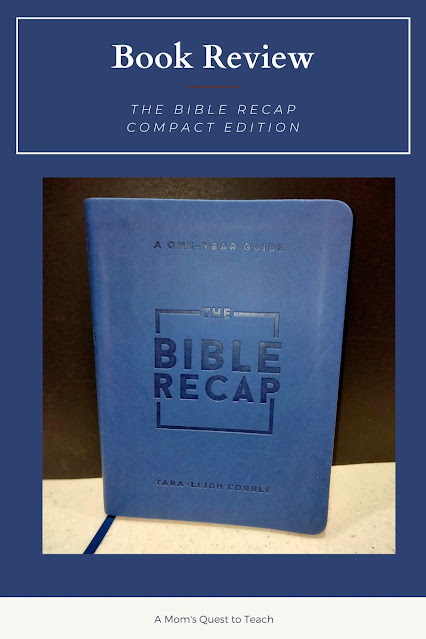I received a COMPLIMENTARY copy of this book from the publisher in exchange for my honest opinion. I was not required to write a positive review nor was I compensated in any other way. This post contains affiliate links. Please see my Terms of Use and Disclosure Policy page for more information. Thank you.
Do you use a Bible reading plan to help you stay on track when reading the Bible? Or perhaps you like a plan to learn more about what you are reading? A Bible reading plan can also help you focus your prayers while reading. The Bible Recap by Tara-Leigh Cobble can help with all those goals. Following a chronological Bible reading plan, The Bible Recap summarizes each day's reading, explains, and connects the Scriptures for you.
The new edition of The Bible Recap is a 759-page compact edition. It has an imitation leather cover with a ribbon marker and a place to list your name in the front. The content is the same as the original edition, providing a one-year guide to help you read and understand the entire Bible.
About the Book
A chronological reading plan is listed as part of the contents, taking you through the entire Bible in 365 days. After an introduction from the author, there is an explanation as to how to use the Book. The Bible Recap quotes from the English Standard Version (ESV), but Cobble mentions other translations you might read. She recommends taking notes and writing questions. You should also keep an eye out for God as you read the Scripture, according to Cobble.
Each day is laid out over two pages. The summary and information are accompanied by "Today's God Shot." This is where Cobble relates how she thinks readers can see God's character. In some of the summaries, the information is simple and straight-forward such as when relating the searching of the sacks of Joseph's brothers:
"The squad opens the bags one by one, oldest to youngest, to heighten the suspense, and finds the cup in Ben's bag" (76).
Sometimes, it is easy to see where Cobble shares her own thoughts, perspective, and ideas in the summaries. For example, when talking about Psalms 102-104, Cobble writes:
"He segues from sharing God's sovereignty and might over all creation into asking God to use His power to wipe out the wicked. While this may sound harsh, we can probably view it less as some kind of personal vendetta and more as a desire for God's glory to be magnified" (263).
At other times, you may need to look for context clues and be discerning to see where Cobble shares her own opinion or that of others on the Bible. Please remember every author of a book about the Bible brings their own knowledge, perspective, and ideas to their work.
My Thoughts
I really appreciate using a chronological Bible reading plan. My husband first introduced the idea to me, but I didn't start reading through the Bible in a year using a chronological plan until I reviewed the first edition of The Bible Recap. For me, it really helps put into perspective the events of the Bible as they took place rather than reading about the same event multiple times spread out through days, weeks, or months.
With Cobble's focus upon looking for God on every page of the Bible, it is sometimes easier to see the common thread in the Bible. God speaks to us on every page – even those that are difficult to understand. I like to read her "God Shot" to see what her thoughts are on the day's reading. Using my own research and knowledge, I can accept what she says or look for a bigger interpretation.
This new compact edition is quite lovely. The first one I received is very large and difficult to take with you. It is actually bigger than my Bible. So having a smaller, compact edition with a ribbon marker makes it very easy to bring The Bible Recap with me. And I love the ribbon marker. Now my bookmark won't fall out!
The imitation leather cover makes this a nice gift option. If the inside cover had "presented to" rather than "this book belongs to," it would be even more appropriate as a gift.
One thing I did like better about the first edition is that with the size of the book, you gained a lot more room to make notes in the margins. This compact edition does not leave much room for note-taking. And the pages are very thin so the ink shows through on the printed text. I haven't written in this book, but I would think anything I write would also bleed through or show through on the other side.
If you enjoyed the earlier edition or accompanying materials to The Bible Recap, this will make a nice addition to your bookshelf. It would be a lovely gift for a family member, church member, or friend.
Reviews of Other Books by Tara-Leigh Cobble
Book Club: Book Review of The Bible Recap Discussion Guide
Book Club: Book Review of The God Shot by Tara-Leigh Cobble
Book Club: Book Review of The Bible Recap

.jpg)





.jpg)